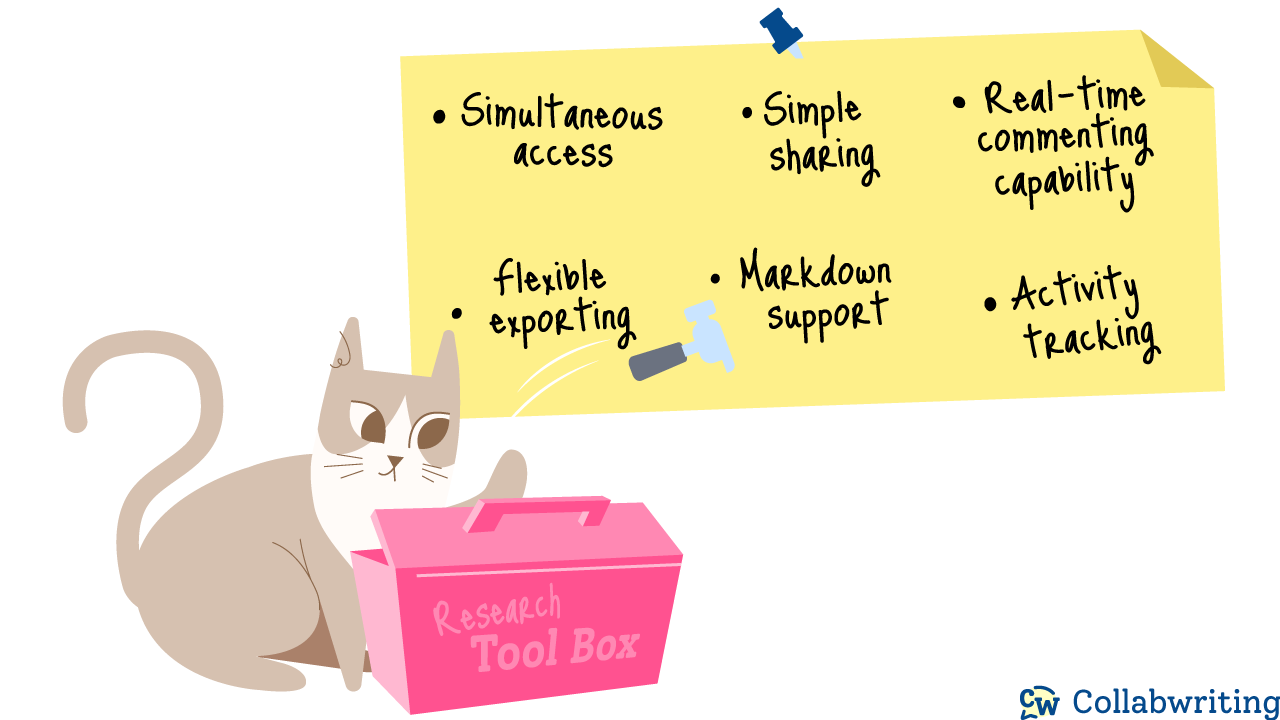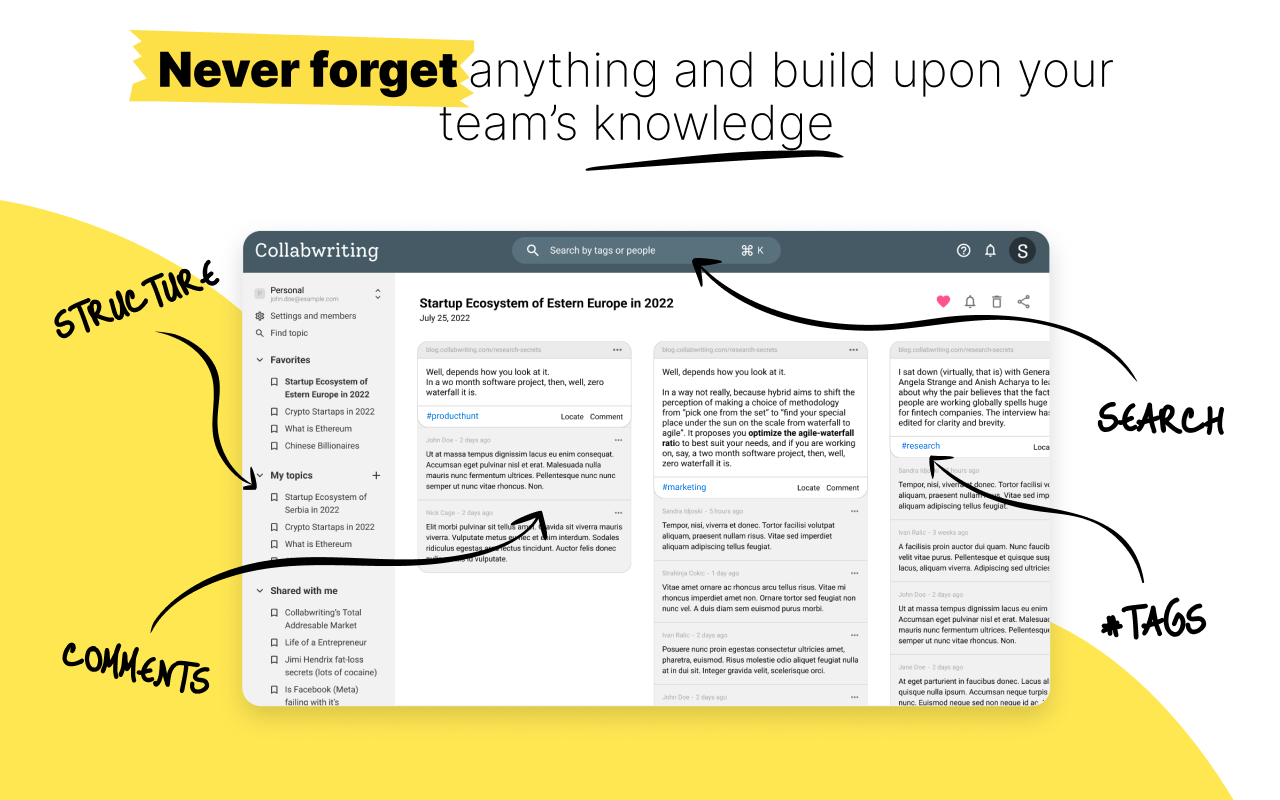Research is an essential part of any academic or professional endeavor. It involves gathering information, analyzing data, and ultimately presenting findings to contribute to the existing body of knowledge.
However, research can be complex and time-consuming, often involving multiple collaborators working on different aspects of the project. This is where collaborative research software comes into play, providing a powerful tool to streamline the research process and enhance collaboration among team members.
Let’s begin!
What makes software collaborative?
Collaborative software is a platform that allows multiple individuals to work together, when it comes to research, oftentimes on creating, editing, and reviewing documents simultaneously.
This is a game-changer, especially for those engaged in in-depth research.
Imagine writers, researchers, or students collecting key insights seamlessly on a single document or webpage, regardless of their physical location. This software facilitates real-time engagement, allowing team members to see each other's changes as they happen, fostering connection and productivity.
With the increasing prevalence of online research, embracing collaborative software becomes essential to streamline processes, enhance teamwork, and maximize productivity.
Collaborative research tools: Features to look for
When evaluating online collaborative research tools, it's essential to consider the following key characteristics:
- Simple sharing: Ensure the tool enables effortless document sharing, allowing collaborators to quickly access and engage with the latest updates.
- Simultaneous access: Look for tools that seamlessly support multiple users searching through the document or webpage simultaneously, minimizing confusion and enhancing productivity.
- Real-time commenting capability: Feedback is essential, so prioritize tools that facilitate easy commenting on specific documents or web page sections to encourage collaboration and constructive input.
- Activity tracking: Effective tools should provide clear visibility of changes made by various collaborators, enabling easy tracking of any changes made.
- Markdown support: Seek tools that offer Markdown export, allowing writers to continue editing their text without skipping a bit.
- Flexible exporting: Opt for writing apps that offer diverse export formats such as PDF, EPUB, and Microsoft Word, ensuring compatibility and versatility when sharing or publishing the final work.

Considering these criteria will help you identify top-notch online collaborative tools that empower effective teamwork and streamline both your writing and research strategy.
Why use collaborative research software?
- Improved efficiency: Collaborative writing software streamlines the research process by reducing the time spent coordinating and consolidating individual contributions. Researchers can work concurrently, eliminating delays caused by waiting for others to finish their part. This increased efficiency can significantly accelerate research project completion.
- Enhanced collaboration: Research often involves multidisciplinary teams with diverse expertise. Collaborative writing platforms create a virtual environment where researchers can easily communicate, share ideas, and collaborate in real time. This fosters collective ownership and promotes synergy, leading to better outcomes.
- Error reduction and quality control: The ability to track changes, review edits, and maintain a centralized document dramatically reduces the chances of errors or omissions. Utilizing collaboration software promotes systematic review and ensures that all aspects of the research project are thoroughly checked, contributing to the overall quality of the work.
- Seamless integration of research components: Research projects typically involve various elements such as literature reviews, data analysis, and results interpretation. Collaboration tools enable researchers to seamlessly integrate these components, ensuring consistency and coherence throughout the document. This holistic approach fosters a more comprehensive understanding of the project.
- Effective communication and feedback: Communication is key in research collaboration. Collaborative writing platforms provide features for commenting, annotating, and providing feedback on specific sections of a document. This streamlined approach enhances clarity and accelerates decision-making, leading to more effective collaboration.
- Accessibility and convenience: By utilizing collaborative writing software, researchers can access their documents from any device. This accessibility eliminates the need for physical file transfers and enables seamless collaboration, even when team members are geographically dispersed.
- Streamlined writer-editor relationship: Collaboration tools play a vital role in the writer-editor relationship. They allow writers and editors to work seamlessly together, keeping track of changes, suggestions, and revisions on one centralized platform. This feature ensures clear communication, eliminates version control issues, and streamlines the editing process. Writers can easily address the editors' comments and suggestions, resulting in a more refined and polished final product.
The seamless integration of collaborative research into your workflow
Creating effective collaboration requires considering your team's unique needs and preferences. Each team develops its own culture, writing style, and workflow, which should be considered. Instead of imposing strict control over collaboration, the focus should be on optimizing the collaborative environment to align with the team's requirements.
When implementing new research software, it's important to consider user adoption and potential resistance to change. To minimize disruption, choose an intuitive user interface that aligns with their existing activities. Avoid overwhelming them with unnecessary additions and features that require extensive re-learning, and strive to provide a seamless transition that respects their established workflows.
With Collabwriting, we have created a powerful real-time collaborative tool that allows teams to collect data, generate ideas, and gather references seamlessly. This tool offers a shareable and searchable system, allowing teams to easily organize and access collaborative content.
The ability to receive feedback and collaborate with team members in real time improves the overall writing experience.

Collabwriting - Shareable Notes on Web Pages and PDFs
Collabwriting allows you to gather all your online sources in one place. Just highlight, save, and collaborate with anyone on any content you find online.
Final notes
Collaborative research and group projects have a knack for nudging us out of our comfort zones. It's true, they can stir up a bit of unease initially. However, these endeavors hold the key to unlocking your potential as a coworker, writer, and reader. They propel you to master the art of coordination, critical analysis, feedback integration, and effective communication.
As long as you embrace the fundamentals, doing research as a team becomes a rewarding adventure for you and your team.






![Best Research Collaboration Tools in 2025: Zotero, Paperpile & Collabwriting [Compared]](/content/images/2025/07/image--7--1.png)







